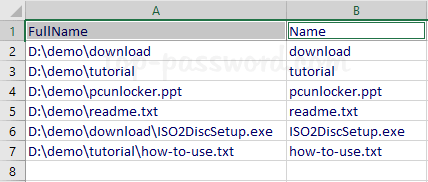

Filelist /USECOLUMNS NAME,EXTENSION,SIZE,FULLPATH,MD5,SHA256 C:\Downloads\ > C:\Downloads\filelist.CSV Say you want to customize the columns that are created by the program, you can use the /USE COLUMNS command to define the format.Į.g. Don't like the default format of the list? FileList supports many parameters, which you can use to include additional properties. Open the document in Microsoft Office Excel or Google Sheets, and it should look much more accessible, with a column for each property. Filelist C:\Downloads\ > C:\Downloads\list.CSV That's precisely what I wanted to highlight, and why you should consider exporting the list to a CSV spreadsheet instead.Īll you have to do is replace the letters TXT in the above command, with CSV.Į.g. Filelist C:\Downloads\ > C:\Downloads\filelist.txtĭon't forget to include the greater than symbol, that's what tells Filelist to save the data as a document.īut wait, even the text document has the same formatting. The syntax for which is Filelist.exe PATH > OUTPUT FILEĮ.g. You can export it to a text document by using a simple command. The formatting makes it difficult to read the list as is in a terminal. In addition to the name of the file, the program also displays other properties such as the file size, last modified, last accessed, creation date, extension and containing path.Īs you can see, Filelist crams a lot of information in the window.

This command creates a list of the files that are located in the Music directory.
Export file listing to text file full#
Just type the word Filelist.exe followed by the full path of the directory that you want to scan. The format that you need to use for obtaining the list of files is simple. Open a command prompt window, preferably in the same directory, so it's easier to type the command.
Export file listing to text file portable#
to put on a backup volume along with the backed up content.įor those who aren't used to command-line tools, don't let it scare you, the program is pretty easy to use.įileList is a portable application, extract it to a folder of your choice. The command-line utility provides a good way to create a record of your files and folders, e.g. FileList is a freeware tool from JAM Software, the developer of TreeSize. He loves long walks on virtual beaches, playing worker placement board games with inconsequential themes, and spending time with his family and menagerie of pets and plants.Cataloging the content of the files can help you further understand what's stored where, sort of like a library record. If you're looking for him after hours, he's probably four search queries and twenty obscenities deep in a DIY project or entranced by the limitless exploration possibilities of some open-world game or another. While his days of steering students toward greatness are behind him, his lifelong desire to delight, entertain, and inform lives on in his work at How-To Geek. In addition to the long run as a tech writer and editor, Jason spent over a decade as a college instructor doing his best to teach a generation of English students that there's more to success than putting your pants on one leg at a time and writing five-paragraph essays. In 2023, he assumed the role of Editor-in-Chief. In 2022, he returned to How-To Geek to focus on one of his biggest tech passions: smart home and home automation. In 2019, he stepped back from his role at Review Geek to focus all his energy on LifeSavvy. With years of awesome fun, writing, and hardware-modding antics at How-To Geek under his belt, Jason helped launch How-To Geek's sister site Review Geek in 2017. After cutting his teeth on tech writing at Lifehacker and working his way up, he left as Weekend Editor and transferred over to How-To Geek in 2010. He's been in love with technology since his earliest memories of writing simple computer programs with his grandfather, but his tech writing career took shape back in 2007 when he joined the Lifehacker team as their very first intern. Jason has over a decade of experience in publishing and has penned thousands of articles during his time at LifeSavvy, Review Geek, How-To Geek, and Lifehacker.

Prior to that, he was the Founding Editor of Review Geek. Prior to his current role, Jason spent several years as Editor-in-Chief of LifeSavvy, How-To Geek's sister site focused on tips, tricks, and advice on everything from kitchen gadgets to home improvement. He oversees the day-to-day operations of the site to ensure readers have the most up-to-date information on everything from operating systems to gadgets. Jason Fitzpatrick is the Editor-in-Chief of How-To Geek.


 0 kommentar(er)
0 kommentar(er)
